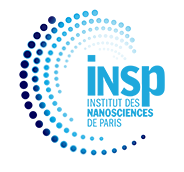Double-pentagon silicon chains in a quasi-1D Si/Ag(001) surface alloy
Résumé
Silicon surface alloys and silicide nanolayers are highly important as contact materials in integrated circuit devices. Here we demonstrate that the submonolayer Si/Ag(001) surface reconstruction, reported to exhibit interesting topological properties, comprises a quasi-one-dimensional Si-Ag surface alloy based on chains of planar double-pentagon Si moieties. This geometry is determined using a combination of density functional theory calculations, scanning tunnelling microscopy, and grazing incidence x-ray diffraction simulations, and yields an electronic structure in excellent agreement with photoemission measurements. This work provides further evidence of pentagonal geometries in 2D materials and heterostructures and elucidates the importance of surface alloying in stabilizing their formation.
A surface alloy is a two-dimensional (2D) mixture of a metal with other elements that is confined within a few atomic layers on a surface, being immiscible in the bulk phase 1-3 . Surface alloys are of particular relevance in heteroepitaxial growth and in heterogeneous and single site catalysis 4-6 and commonly form well-ordered 2D layers 7-9 and nanostructured phases 10-14 . Of recent interest is their functionality as a precursor or even a scaffold for 2D growth of MoS 2 15 and monoelemental Xenes like tellurene 16 , stanene 17,18 , thallene 19 , antimonene 20 , as well as silicene, the silicon analogue of graphene 21-24 . Along with nanoscale silicides, surface alloys of silicon are of particular technological relevance due to their use as a contact material in microelectronic devices 25 .
Surface alloy formation typically begins with the ejection of substrate (metal) atoms from the top layer followed by insertion and/or substitution of adsorbate atoms 3 . The silicon-silver interface is a prototypical system for studying this atom-exchange mechanism. During the growth of Si/Ag(111), the topmost layer of Ag is replaced by a continuous sheet of silicene 26-29 . In contrast, on Si/Ag(110) 27,30 , the initial ejection of Ag atoms accompanies the formation of pentagonal Si clusters 31 , seeding the growth of a surface alloy of pentagonal Si nanoribbons in Ag missing rows 32-34 , before leading at higher coverage to the appearance of a dumbbell silicene layer 35 , predicted to constitute the true ground state of 2D silicon 36 .
The phenomenon and relevance of surface alloying in the Si/ Ag(001) system has drawn recent specific attention 37 . The first experimental studies were performed nearly two decades ago by Leandri and coworkers 38-40 . They reported that Si deposition results in the formation of a low coverage (3 × 3) phase based on 1D tetramer stripes with subsequent formation at higher Si coverage of a complex striped superstructure having a hexagonal pattern. Although the precise atomic structure of the latter remains unknown 41,42 , a simple surface alloy geometry of the (3 × 3) phase was recently proposed and identified as a potential model system for studying novel physical phenomena of confined systems, specifically the Su-Schrieffer-Heeger model of topological excitations 37 .
In this work, we elucidate the atomic structure and electronic properties of the (3 × 3) reconstruction of Si/Ag(001) using a combination of particle swarm optimization, atomistic thermodynamics within density functional theory (DFT), scanning tunnelling microscopy (STM) measurements, and DFT simulations of surface X-ray diffraction (SXRD) and angle-resolved photoelectron spectroscopy (ARPES) measurements. Like for the other two silver surfaces, silicon deposition is shown to cause silver atom ejection from the topmost
| Origine | Fichiers éditeurs autorisés sur une archive ouverte |
|---|---|
| licence |



